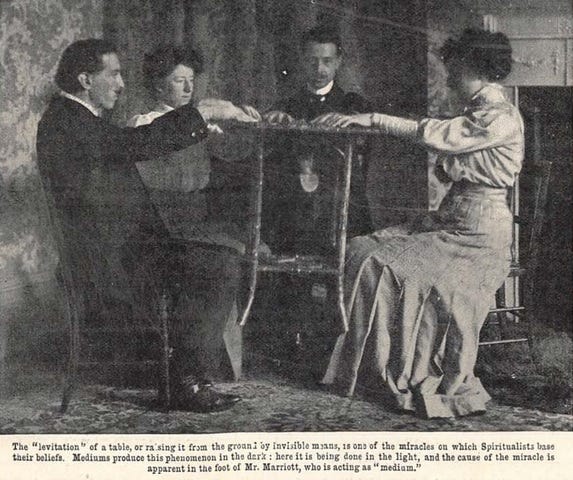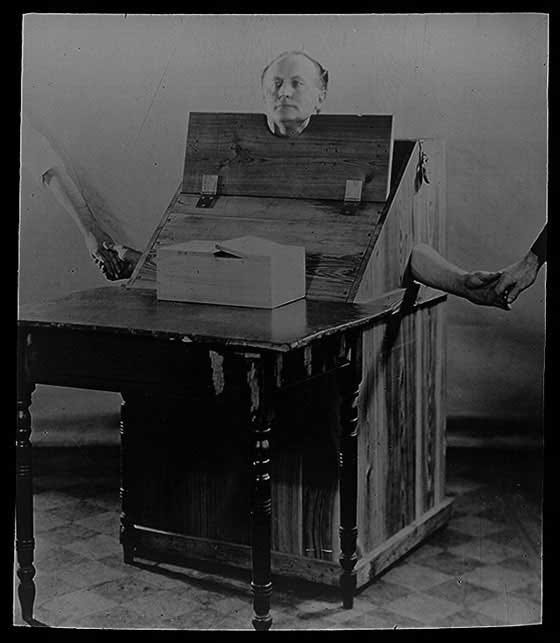The Prohibition Era May Have Lacked Some Spirits but Not Others:
Early 20th Century Spiritualist Revival, Occult in Cinema, and Houdini’s Contentious Friendship with Sir Arthur Conan Doyle and His War Against the Spirit Mediums
Spiritualism is a religious movement based on the belief that the spirits of the dead exist and have both the ability and the inclination to communicate with the living.
Throughout history, even back into antiquity, there have always been accounts of unusual people with the gift (or perhaps curse) of conferring with those no longer inhabiting our earthly plane. Such claims and stories tend to be largely dismissed as either lies made by fraudsters in the worst of cases, or hallucinations by earnest but delusional persons in the best of cases. Yet there is no denying that the topic interests even those who would call themselves a skeptic.
Spiritualism’s more modern roots as an organized movement or religion began in upstate New York in 1848 when a family became disturbed by harassing rapping noises made by a seemingly invisible actor at all hours of the day and night. It soon became obvious that the two daughters, known as the Fox sisters, were the attractors of the ghostly attention and thus devised a code to communicate with the unknown spirit through rapping sounds. As word spread of their ability to converse with the deceased and restless spirit (who they claimed was “the spirit of a murdered peddler whose body was found in the house”) people came from far and wide to witness these interactions. These displays of spirit interaction were the early séances, and the Fox sisters were the first celebrity spirit mediums.
Many years later in 1888 the Fox sisters would admit that it was a hoax and that the rapping sounds made by the ghostly spirit were in fact made by the cracking of their toes, but in the interim the displays of seemingly supernatural skill gained them and the Spiritualist cause an enthusiastic following and the movement spread abroad into England. Spiritualism naturally received opposition and might frequently and mistakenly receive the label of witchcraft or necromancy. The highly publicized instances of outright fraud by phony spirit mediums who resorted to tricks, such as the Fox sisters, also served to weaken the cause.
WW1: Mass Death and Worldwide Grief
It needs not be said that the sheer amount of casualties that resulted from World War I (1914-1918) was felt keenly across the globe. The world, it seemed, was wallowing in a collective state of grief. An unconventional balm to the grief of losing one (or sometimes several ones) so abruptly and violently presented itself in the form of Spiritualism. It promised a means to speak once again to those who were so dearly loved and lost. Sir Arthur Conan Doyle had a similar experience when his son Kingsley had died in the war in 1918 and Doyle claimed he was able to make contact with him through the help of a spirit medium, though it should be noted that Doyle had expressed an interest in Spiritualism even prior to the passing of his son.

Sir Arthur Conan Doyle, a man widely respected and admired as both a medical doctor and the famous author of the Sherlock Holmes books, lent the Spiritualist movement an air of dignity, and a good deal more legitimacy than it might otherwise have had. Doyle went on to become a very vocal and highly publicized proponent of the religion and would frequently evangelize Spiritualism through lectures, books, and articles both domestically in England and abroad in the States. It was on one of these lecture tours in the US that Doyle and the famous magician Houdini came to meet.
The friendship would ultimately prove itself to be an inconstant and contentious one until Houdini’s death but there is not doubt that they shared a fond affection and genuine respect for each other. Like Doyle, Houdini had a passionate interest in Spiritualism but not in the positive sense that Doyle did. Houdini became equally as vocal and publicized on the topic of Spiritualism as Doyle was, but his message was that spirit mediums were sophisticated frauds swindling the vulnerable and aggrieved population, and that contact with the spirits of the deceased was not attainable. As a magician Houdini was intimately aware of the type of trickery employed in pulling off convincing illusions such as levitating tables, reading minds, and even spirit writing.
Scientific(?) American
At the behest of Sir Conan Doyle in 1922, the Scientific American issued a contest worth $5,000 to any supposed spirit mediums who could provide conclusive evidence of psychic phenomena. The jury was comprised of a Harvard psychology professor, a MIT engineer and physicist, two researchers specializing in psychic phenomena, and Houdini himself (much to Doyle’s dismay). The panel was witness to innumerous seances throughout the duration of the contest, some blatantly phony and others astonishingly convincing. The most believable of those being hosted by Mina Crandon, under the alias of Margery. Here the story really starts to get truly bizarre and if you care to dig deeper into the Scientific American contest, Houdini’s crusade against spirit mediums, spirit photography and ectoplasm, and a lot of other spooky goings on occurring in the 1920s I would highly recommend checking out The Witch of Lime Street by David Jaher.
Sir Arthur Conan Doyle’s Involvement in Other Dubious and Mystical Events
Photographic Evidence of Fairies (The Cottingley Fairies) - The old man was duped by a pair of little girls.
The 11 Day Disappearance of Agatha Christie - During her disappearance he hosted an impressive search and public campaign to find her. He even employed a spirit medium to assist in finding her whereabouts.
The Occult in Early Cinema
I might make this an ongoing section as there are quite a lot of fascinating (and oftentimes cheesy) references to the Occult in early film. The Victorian, Edwardian, and post-Edwardian age found itself highly interested in all things “exotic”, esoteric, mystical, and macabre. Something commonly featured in horror films of the 20s-40s was the séance scene. Here are a couple of my favorite examples:
Dr. Mabuse the Gambler (1922)
Supernatural (1933)
Charlie Chan’s Secret (1936)
Charlie Chan at Treasure Island (1939)
The Uninvited (1944)
13 Ghosts (1960)
My Books Reviews (during the period of September 1 - September 17)
Ten Days in a Mad-House by Nellie Bly
Proposed Topics for the Next Issue *
Bitches Be Crazy - Female Hysteria, Insanity, and Witchcraft
The Northanger 'Horrid' Novels: The 7 Gothic Books Referenced in Northanger Abbey
More Spooky TBR Books
Halloween Movie Curation for the First Half of October
My Book Reviews for the period during… - Standing item for all newsletters
*I reserve the right to change topics prior to publication of subsequent issues but my intent will be to stick to the plan.







